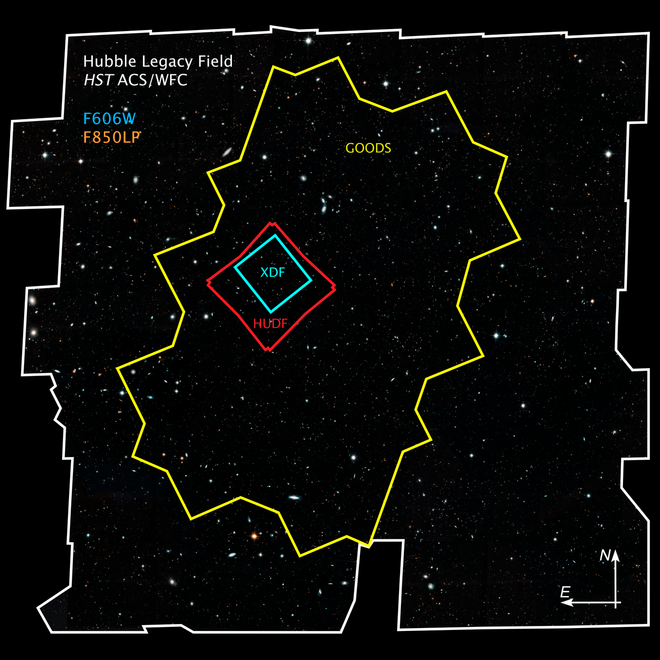Data
Surveys and Datesets That We Released and are working with
The Hubble Legacy Fields
The first deep exposures with the Hubble Space Telescope (HST) have transformed our view of the Universe. Over the following more than two decades, HST has identified an unprecedented number of galaxies out to z~11, at only ~400 Myr after the Big Bang, allowing us to study galaxy build-up across 97% of cosmic history. The main drivers of this discovery have been concerted efforts to combine ultra-deep exposures with larger area surveys. The area of the Chandra Deep Field South which contains the Hubble Ultra deep field embedded in the GOODS-South and GEMS fields was of particular importance. Over the lifetime of HST, this area has been imaged with a total exposure time of almost 6 Ms in 7211 exposures from about 2442 orbits. This is ~70% of a HST full cycle. Our team has processed all these data and combined them into a high-level science product, the Hubble Legacy Field for the GOODS-South region. The full data release can be found on the MAST archive, here.

source: hubblesite.org
Ultra-Deep IRAC Imaging
Before the advent of the JWST, rest-frame optical imaging of early galaxies can only be obtained with the Spitzer Space Telescope. Such information is crucial in order to reliably estimate stellar masses of galaxies and to exclude lower redshift contaminants such as very dusty or evolved galaxies which can sometimes mimick the selection of high-redshift Lyman Break Galaxies. Building on our pilot program over the GOODS-South field, we are now conducting a very large (733 hr) program to cover a large area of the GOODS-North and South fields to 200 hour depth reaching to ~27 mag AB at 5sigma.
For our release of all the previous IRAC imaging over GOODS-South see here. A small area already now extends to 200 hour depth, revealing a large fraction of significant detections of very faint z~7-8 galaxies with Spitzer.
The Hubble Deep UV (HDUV) Survey
The HDUV is a cycle 22 legacy UV imaging survey of the two CANDELS-Deep fields in GOODS-North and -South. Our program will build on existing WFC3/UVIS data to obtain deep images at 250-350 nm (in F275W and F336W). These data will provide the first complete census of low-luminosity star-forming galaxies at z~0.5-2 and enable a wealth of research by the community. This includes measuring the physical properties of sub-L* galaxies, and characterizing resolved stellar populations to decipher the build-up of the Hubble sequence from sub-galactic clumps. For more information see the survey webpage.

The Hubble Frontier Fields
The Frontier Fields are a large legacy program performed with the Hubble Space Telescope through Directors Discretionary time. The survey makes use of lensing magnification from foreground clusters to probe intrinsically extremely faint galaxies. In total, 840 orbits are invested in very deep optical ACS and near-infrared WFC3 imaging over 6 clusters and 6 parallel fields. Additionally, very deep Spitzer imaging has been taken as well as other multi-wavelength data to complement the investment with HST. This is a prime dataset for high-redshift galaxy science over the next few years. We are directly involved in creating high-level, science-ready catalogs for the community through an HST archival program (PI: Marchesini). For more information on the Frontier Fields see here.
Millimeter Constraints at High Redshift
ALMA in the South and NOEMA in the North cover a completely new parameter space to study early galaxies at millimeter wavelengths. These two interferometers directly probe dust emission and cover a wealth of molecular and fine-structure emission lines of high-redshift galaxies. We are part of several ALMA programs to study the dust continuum and far-IR emission lines of star-forming z>3 galaxies and to perform a molecular line scan of galaxies in the Hubble Ultra-Deep Field.
REBELS: (Reionization Era Bright Emission Line Survey)
REBELS is a new ALMA large program of 70-hour approved for execution in cycle 7. We will construct the first statistical samples of galaxies at z>6.5 that are bright both in their far-IR continuum emission (from dust reprocessed light) and their ISM cooling lines. REBELS will identify these galaxies by targeting 40 of the brightest z=6.5-9.5 galaxies (in the UV) over a 7 square-degree area with well-constrained redshifts and scanning for either the 157.7 micron [CII] line or the 88.4 micron [OIII] line. For more information see the survey webpage.

